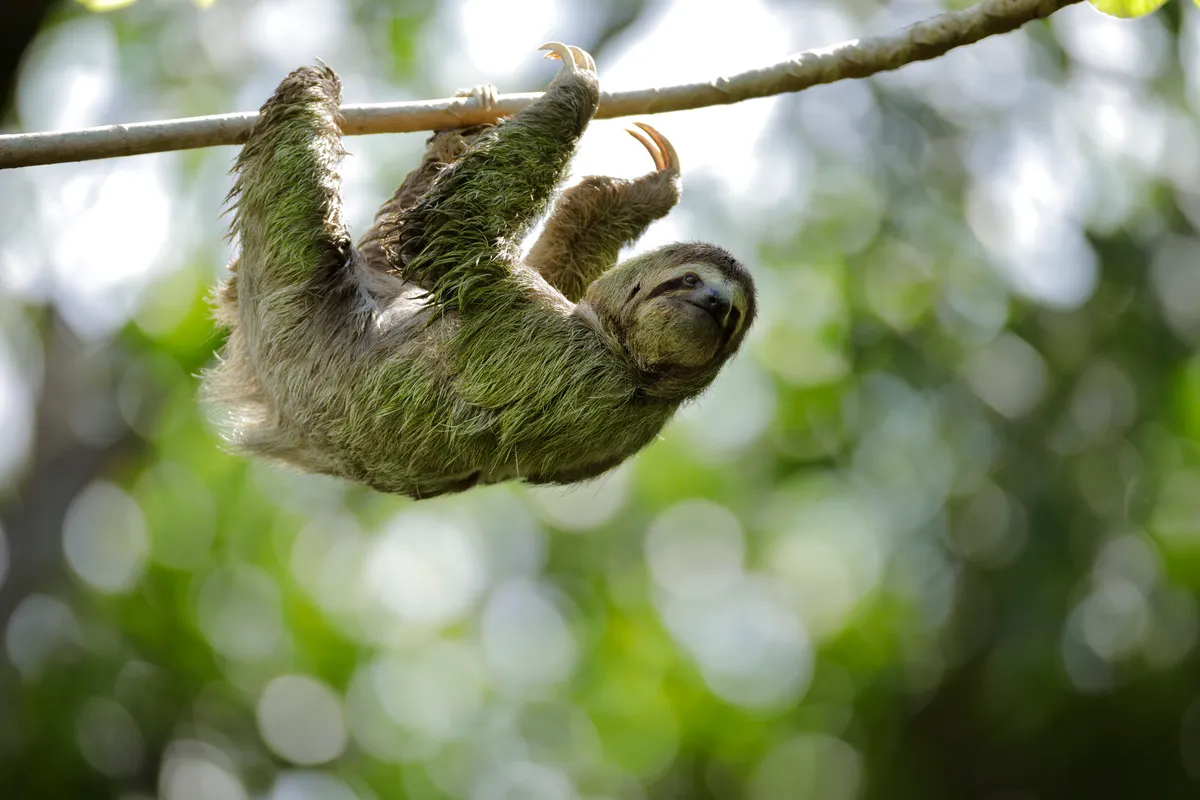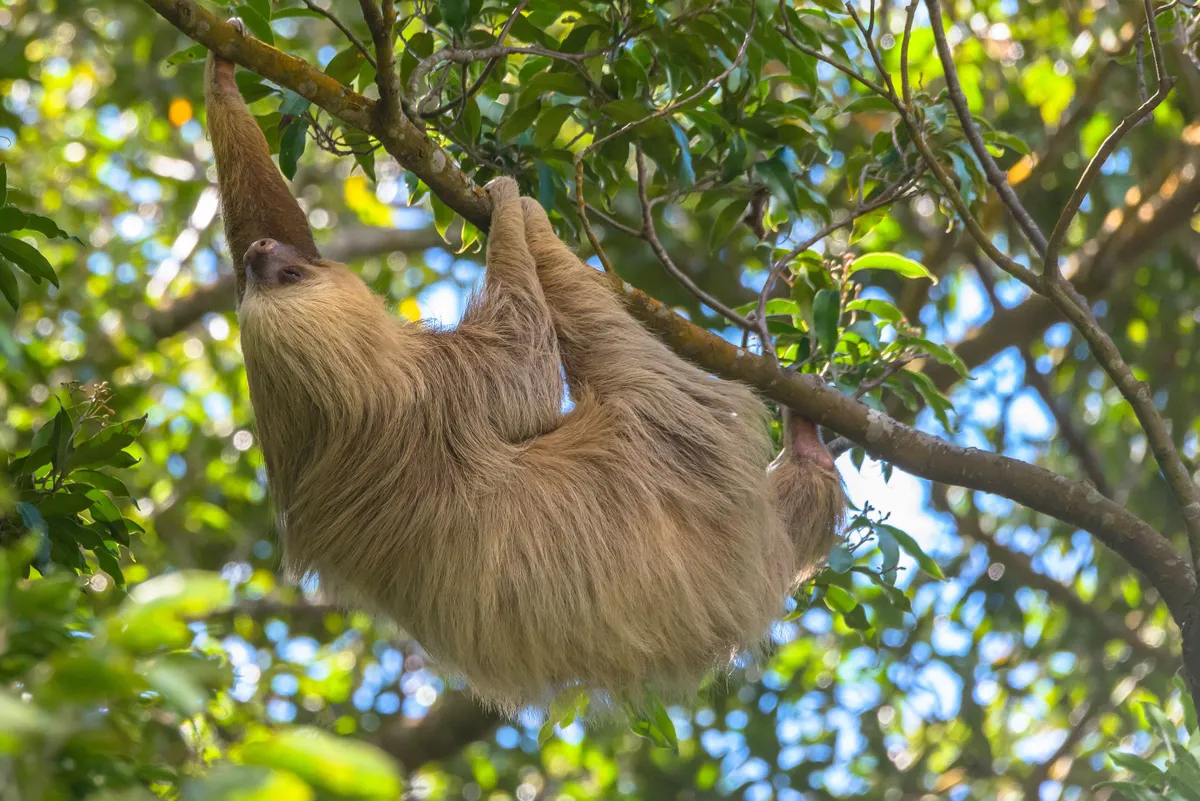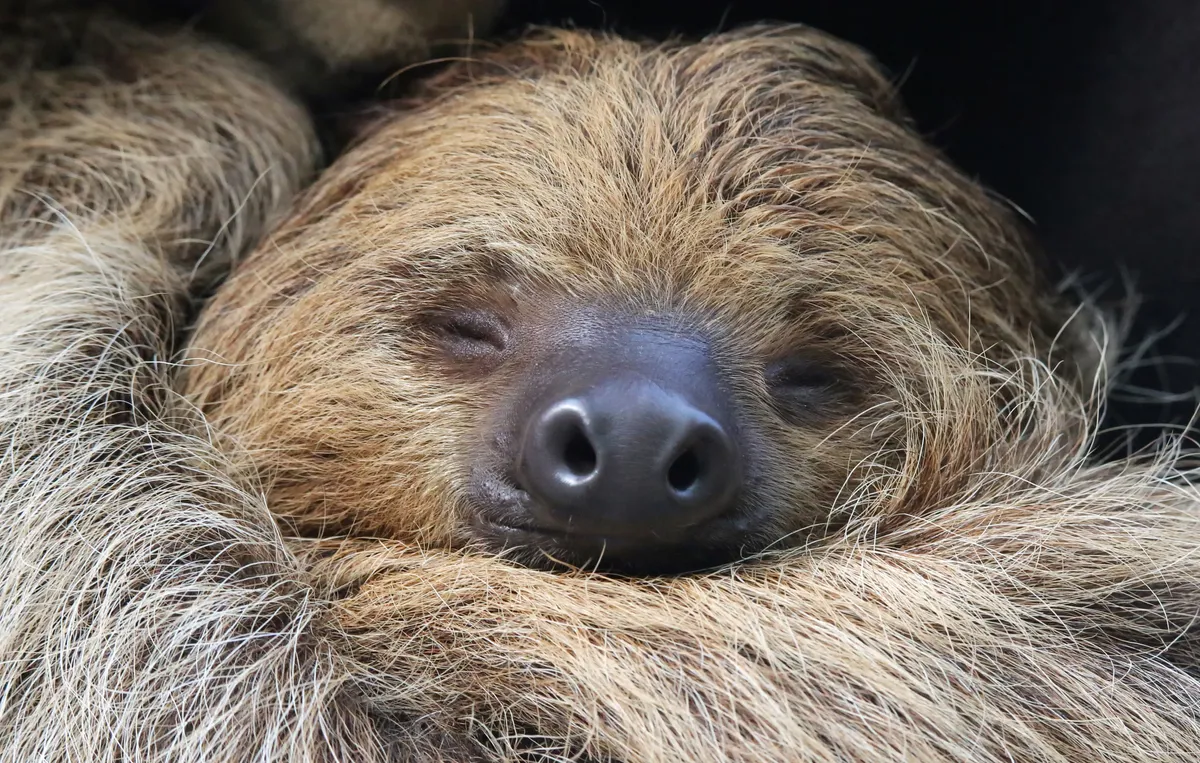Costa Rican naturalist Percy Piedra points to the bough of a cecropia tree drooping over a murky brown river that twists and winds through Tortuguero National Park. Even viewed through his telescope, the animal - a sloth - he has spotted is almost invisible, its body having blended into a knotted tangle of branches and leaves. Only when a rangy limb begins to scratch sluggishly at a mass of grey-green fur virtually indistinguishable from the vegetation does the creature finally betray its hiding place.
For Jade, visiting Costa Rica from Texas, the sighting is enough to bring her to the verge of tears. “This is the first time I’ve seen a sloth in the wild,” she chokes. “I’ve been dreaming of this for years.”
A lazy reputation
The sloth hasn’t always been viewed with such enthusiasm. Its earliest mention in historical literature was recorded by the Spanish colonialist Oviedo, who declared that the sloth was “the stupidest animal that can be found in the world”, adding that he had “never seen such an ugly animal or one that is more useless”. Sloths are also, quite literally, synonymous with laziness no matter which language you’re referring to them in, and they suffer the additional ignominy of sharing their name with the seventh deadly sin.

Fast forward to the social media era and the sloth has – in a rather un-sloth-like fashion – rapidly become an online sensation.
Zara Palmer, marketing manager for the Toucan Rescue Ranch, one of Costa Rica’s most respected wildlife rehabilitation centres, calls them “the new kittens of the internet” and explains how their popularity was key to securing funds while the centre was closed during the pandemic. “If we post a picture of one of our owls, toucans or even the spider-monkeys, we’ll get maybe a few hundred ‘likes’. But the sloths? They really blow up.”
Costa Rica's national symbol
Costa Rica is home to two of the six species of sloth – the Hoffman’s two-toed sloth and the brown-throated three-toed sloth – and their burgeoning popularity hasn’t gone unnoticed by the Costa Rican government; in July 2021, it was declared that both species had been inaugurated as a new national symbol. This announcement came at a time when Costa Rica was tentatively reopening to tourists following the collapse of international travel during the Covid-19 pandemic.
Long celebrated as the premier destination for eco-conscious holidaymakers due to its world-leading attitudes towards sustainable tourism, the pandemic almost spelt disaster for many of the country’s pioneering, community-led conservation projects that rely so heavily on visitors for their income. Now, Costa Rica’s borders have been flung open and the sloth has found itself at the centre of the tourism board’s marketing campaign to bring back the much-needed tourists.
They’re not lazy at all, they’re efficient.
What, then, has turned the humble sloth from the much-maligned creature of yesteryear into one of the internet’s most beloved animals and the unwitting ambassador for the modern Costa Rican tourism industry?
For some, their appeal lies in precisely that with which Oviedo took issue. Where once sloths were vilified for their apparent laziness, now their languid movements, breezy charm and seemingly carefree attitude have inspired thousands of millennials to pay homage to their ‘spirit animals’ in the comments sections of the countless viral sloth videos that have flooded TikTok and Instagram. But for zoologist Sam Trull, a lot of this love is based on a fundamental misconception. “They’re not lazy at all,” she says. “They’re efficient.”
The sloth's secret to success

The secrets to the sloth’s success, says Sam, are its abilities to conserve energy and go undetected, both of which are at the centre of all its characteristics and behaviours, including its slowness. No other mammal has a slower metabolism or less muscle mass than sloths, meaning they can take on fewer calories and don’t have to expend as much energy looking for food.
Their painstaking movements mean they can avoid catching the eye of any potential predators, as does their unique approach to camouflage. The sloth is so sedentary that its long, coarse fur becomes a breeding ground for fungi and algae, which in turn lend the sloth its greenish hue – perfect for blending in with the rainforest canopy.
But while their slowness might be an essential strategy for survival, sloths can also show a surprising turn of speed when the occasion permits. “When they feel threatened, they can bite and slash as fast as any animal,” says Sam. “One of the main reasons we’re called out for a rescue, other than electrocutions, is dog attacks, which happen when a sloth comes down to defecate. Often it’s the dog that comes off worse from the encounter.”
Pedro Montero, a local conservationist and sloth specialist, adds that far from being an evolutionary anomaly, the sloth is actually one of the most successful examples of natural selection, with a lineage that reaches back tens of millions of years. It had previously been thought that the two types of sloth around today – the three-toed sloth and the two-toed sloth, both arboreal – evolved separately from the giant ground sloths that once roamed the Americas.
However, more recent research has shown that both are directly related to the elephant-sized sloths and were in fact part of the same family before a genetic split took place some 20 million years ago. What followed was what scientists call an evolutionary convergence: the two different families of sloth each took to the trees and underwent similar adaptations to their conditions. Despite their shared qualities, the two-toed sloth and the three-toed sloth are, in fact, very distant relatives, each millions of years in the making.
Conservation challenges and the fight for survival
Despite its Darwinian credentials however, the 21st-century sloth is having a tough time contending with challenges that its prehistoric ancestors never had to face.
Costa Rica is deservedly championed as a world leader in conservation – to date, it’s the only country in the world to have halted, and subsequently reversed, deforestation. But it hasn’t been able to completely prevent humans from encroaching on the sloth’s habitat.
The main threat comes from the overhead power lines that criss-cross the roads that cut through the sloth’s rainforest home. “Sloths will always take the easiest route,” says Zara, “and they can’t tell the difference between a vine and a power cable.” Most of the sloths undergoing rehabilitation at the Toucan Rescue Ranch have been orphaned while being carried along the powerlines by their mothers, or have been electrocuted themselves. These sloths are the lucky ones; the vast majority are killed instantly and the road through the coastal rainforest from Manuel Antonio to Uvita is littered with the corpses of those that never made it to the other side.
Sloths will always take the easiest route, and they can’t tell the difference between a vine and a power cable
Work is being done to try and protect sloths from the threat of electrocution. Campaigns have been started to call for exposed overhead electrical wires to be fitted with proper rubber insulation, while non-invasive rope bridges – ironically named ‘speedways’ – have been built in the treetops to provide sloths with a safer route between different parts of the forest. Nevertheless, it has been impossible to prevent sloths from taking to the powerlines altogether and the role of rescue centres like the Toucan Rescue Ranch in rehabilitating and rewilding the constant stream of injured arrivals has never been more important.
Early attempts to rehabilitate and release rescued sloths in Costa Rica were far from productive. Research on the physiology and behaviour of these mysterious mammals was limited and despite the well-meaning effort that was put into training them for life in the forest, releasing recovered sloths back into the wild proved to be a death sentence.

The situation seemed hopeless; as Sam puts it, “The conclusion that researchers drew was that sloths were basically too dumb to learn how to be sloths.” This all changed when Sam co-founded the Sloth Institute, a Costa Rican-based non-profit that placed the studying of sloths at the core of its conservation mission. Thousands of hours spent meticulously observing sloths in their natural habitat to monitor their behaviours and eating patterns allowed Sam and her team to design a rewilding ‘boot camp’ for orphaned and injured individuals, which has enjoyed extraordinary success. Thanks to the Sloth Institute and its partners, hundreds of rescued and rehabilitated sloths in Costa Rica have been able to thrive on their return to the rainforest.
Sam’s detailed approach to tracking sloths post-release has also put the Sloth Institute on the cutting edge of sloth research and has led to some interesting discoveries. She refers to the example of Mr Valentine, a sloth that was electrocuted on Valentine’s Day 2020 while climbing across an overhead power cable. He recovered well and was released several kilometres away from where his accident took place.
Mr Valentine's story
In March the following year, the Sloth Institute was called out to rescue another sloth who had been electrocuted by the same power cable. They identified the sloth by his microchip as the very same Mr Valentine who had been injured there the year before. “Not only had he made it all the way back to where we’d originally rescued him, but he was also electrocuted at the same time of year,” says Sam. “This shows us how amazing sloths’ spatial memory capabilities can be. It tells us they probably travel to the same forests every season based on food availability.”
Mr Valentine has since made another full recovery and has been released even further away from his favourite power cable. “Let’s see next February if we see him again,” jokes Sam.
Mr Valentine’s story highlights the uphill battle that Costa Rica’s sloth rescue centres are facing to protect the animals. In one day, the Sloth Institute might release one sloth and receive a call to take in two more. As Sam puts it, “It’s like putting a band-aid on an artery that’s bleeding out.”
But there is cause for optimism. With the country’s borders reopening, the money generated by tourism is starting to trickle back into the conservation projects that protect the environment and its biodiversity.
Sustainability has always been at the heart of Costa Rica’s ecotourism philosophy, and the pandemic has provided the opportunity for hotels and resorts to lean further into this by providing experiences for international guests looking to reconnect with nature after months spent indoors. The Parador Hotel Resort in Manuel Antonio, for example, now employs resident naturalists such as Elias Mora to lead wildlife tours on the property’s grounds in the middle of the coastal rainforest. Howler monkeys, white-faced capuchins and a resplendent variety of tropical birds can all be found roaming the hotel’s forest trails. But the most popular animal? “People just love the sloths,” says Elias.
Back on the waterways of Tortuguero, Percy explains to the boatful of tourists exactly why the sloth has been adopted as Costa Rica’s newest national symbol. “Our symbols are important for how we want to represent our country to the world. The sloth represents the spirit of our people. Pura Vida [the pure, or simple, life] – slow down and you’ll achieve more than if you try to rush through life.” This has, after all, been the secret behind the sloth’s success so far.
And now, with its future being safeguarded by organisations like the Sloth Institute and the Toucan Rescue Ranch, the unassuming sloth may well play an important role in shaping the fortunes of Costa Rica as the unlikely poster child for its post-pandemic ecotourism industry.
#NoAnimalSelfies
Social media’s obsession with sloths is something of a double-edged sword. As well as helping raise funds for sloth protection, the demand for close-up encounters with sloths has seen them become one of the world’s most ‘selfied’ animals. This has fuelled illegal wildlife trafficking in the Central Americas, where mothers are killed so their babies can be used as props for tourists. Most people who pose with sloths are unaware of the cruelty that goes on beyond the scenes, hence Costa Rica launched its #NoAnimalSelfies campaign in 2019 to raise awareness of the issue. Today, holding any wild animal in Costa Rica for the purpose of taking a photograph is illegal.
What's the difference between two-toed' and 'three-toed' sloths?
The terms ‘two-toed’ and ‘three-toed’ for the two families of sloth are misnomers: both types have two toes on their hindlimbs, but different numbers of ‘fingers’ on their forelimbs. There are other subtle differences between the two sloth species in Costa Rica.
Hoffman’s two-toed sloth

- Six vertebrae in the neck, allowing them a maximum of 90° of head rotation
- Larger; up to 75cm in length and 9kg in weight
- More solitary and territorial
- Two ‘fingers’ on their forelimbs
Brown-throated sloth

- Occasionally known to group together with other sloths
- Nine vertebrae in the neck, allowing them 270° of head rotation
- Smaller; up to 60cm in length and 5kg in weight
Doug Loynes is a British writer and wildlife enthusiast based in Brazil. The winner of National Geographic’s 2020 Travel Writing competition, his work on sustainable tourism has featured in a number of publications.
Main image: Close-up view of a two-toed sloth. © Tane Mahuta/Getty




